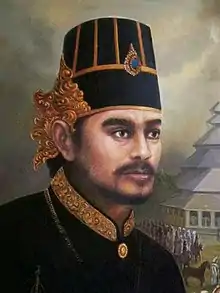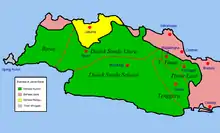Bantenese people
The Bantenese (Sundanese: ᮅᮛᮀ ᮘᮃᮔ᮪ᮒᮨᮔ᮪, Urang Banten) are an group ethnic of the Sundanese people, native to Banten Province on the island of Java, Indonesia. The area of Banten province corresponds more or less with the area of the former Banten Sultanate, a Banten nation state that precedes Indonesia.[2] In his book "The Sultanate of Banten", Guillot Claude writes on page 35: “These estates, owned by the Bantenese of Chinese origin, were concentrated around the village of Kelapadua.”[3] Most of Bantenese are Sunni Muslim.
 Bantenese couple at a wedding | |
| Total population | |
|---|---|
| 4,657,784 (2010 census)[1] | |
| Regions with significant populations | |
| Banten | 4,321,991 |
| Lampung | 172,403 |
| West Java | 60,948 |
| North Sumatra | 46,640 |
| Jakarta | 28,551 |
| South Sumatra | 17,141 |
| Languages | |
| Sundanese language (Bantenese dialect), Indonesian | |
| Religion | |
| Predominantly Sunni Islam | |
| Related ethnic groups | |
| Baduy, Sundanese, Betawi | |
2010 Population Census
According to the 2010 Population Census carried out by the Central Bureau of Statistics Indonesia, the Bantenese people along with the Baduy people are categorized under the Native Bantenese people with a total of 4,657,784 people.[4][1]
Origins

The origins of the Bantenese people; which are closely related to the Banten Sultanate, are different from the Cirebonese people who are not part of the Sundanese people nor the Javanese people (unless it is from the result of a mixture of two major cultures, namely Sundanese and Javanese). The Bantenese people along with the Baduy people (Kanekes) are essentially a subgroup of the Sundanese people of the former Banten Sultanate (region of Bantam Residency after the abolishment and annexation by the Dutch East Indies). After the formation of the Banten Province only did people began to regard the Bantenese as a group of people with a culture and language of their own.[5]
Language
The most dominant language is Bantenese, is a dialect or variant of the Sundanese, typical of Banten.[6][7] The dialect is colloquially referred to as "informal or harsh layer" in modern Sundanese language.[8]
Sundanese in the West Java region has a distinct layer due to the influence of the Javanese culture during the reign of the Sultanate of Mataram kingdom, the Sundanese language - especially in the Parahyangan area - have different layers starting from the most formal, or "halus/lemes" version, to the everyday "loma/lancaran" version and the informal or harsh version. Mataram Sultanate tried to take control over Java island, including Banten territory covering the whole West Java region, Sultanate of Banten could defend its territory except Parahyangan area. In the mountainous regions and most of present-day Banten, the loma version of Sundanese language is the most dominant. By contrast, this version is considered "harsh" by people from Parahyangan. Bantenese language is commonly used especially in the southern region of Banten such as Pandeglang Regency and Lebak Regency. [9]
However, around Serang and Cilegon, Banten Province, a dialect of the Javanese language, the Banyumasan is also spoken by about 500,000 people.[10] And, in Northern part of Tangerang, Indonesian language with Betawi dialect is also used by Betawi immigrants. Besides Sundanese, Javanese and Betawi dialect, Indonesian language is also widely spoken especially by other ethnic immigrants from other parts of Indonesia especially in urban centers.
Religion
Those who considered themselves as Bantenese are generally practicing Muslims, which is due to being inseparable from a strong Islamic cultural background. This case is also closely related to the history of Banten Sultanate as one of the largest Islamic kingdom in the island of Java. Besides that, the artistry in Banten region also portrays Islamic activities of its society, such as art Rampak Bedug from Pandeglang Regency.[11] Even so, Banten Province is a multi-ethnic society consisting of various ethnics and religions.[1] Adherents of other faiths from various non-indigenous ethnic groups live alongside each other peacefully in this region, such as the Benteng Chinese community in Tangerang and the Baduy people that practices Sunda Wiwitan in Kanekes, Leuwidamar, Lebak Regency.
Culture

The land of Banten is rich in culture and customs, and one of the most dominant is Banten culture and customs which is different from Sundanese culture in West Java.
Art forms
The cultural distinctiveness of the Bantenese community among other is Pencak Silat martial arts, Debus, Rudad, Umbruk, Saman dance (Dzikir Saman), Tari topeng,[12] Dog-dog, Angklung Gubrag, Rampak Bedug, Walijamaliha dance,[13] Silat Pandeglang dance,[11][14] Palingtung, Lojor, Beluk and so on.[15][16]
Historical landmarks
In addition, there are also relics of ancestral heritage, and among them are such as the Great Mosque of Banten, the Sacred Long Mausoleum[17] and many more.



Culinary

Bantenese culinary includes Sate Bandeng, Rabeg Banten, Pasung Beureum, Ketan Bintul, Nasi Belut, Kue Cucur, Angeun Lada, Balok Menes, Sate Bebek Cibeber, Emping Menes[15][16] and others.[18][19][20]
Bantenese batik textile

The pattern and motifs of Bantenese batik is the illumination of decorative design that have been studied by the Banten government as part of the framework of rediscovering ornamental motifs from traditional Bantenese houses. These decorative designs came about as a result of the reconstructions from the excavations made by the National Archaeology and the Faculty of Literature, Universitas Indonesia since 1976. The decorative designs are then decided by the Banten governor in 2003.
Ever since its patenting in 2003, Bantenese batik has undergone a long process until it was finally recognized globally. The Bantenese batik was patented after it was predicated through studies done in Malaysia, Singapore and then followed by another 62 countries. In fact, Bantenese batik was the first batik with patent rights in the UNESCO.
Bantenese batik possesses the storytelling identity and its own uniqueness in comparison to other batiks. Several of its motifs are adopted from historical artifacts. Grayish colors can be found in every motifs, which is supposed to reflect the Banten community. All of the batik contains philosophical meaning.[21]
Names of the Bantenese batik motifs are taken from the toponym of ancient village names, the title of nobles or sultan and the name of the court palace of Banten. Even the patterns are synonymous with historical stories that contain meaningful philosophies and on the motifs bears intellectual meaning for the wearer of Bantenese batik materials and clothing.[22]
Philosophy behind Bantenese batik motifs
- Surosowan motif: Surosowan is the name of the spatial layout facing the king / sultan of the Banten Sultanate.
- Pasulamam motif: Pasulaman is the name of the place of the embroidery craftsmen within the Banten Sultanate.
- Pasepen motif: Pasepen is the name of the place in the palace where Sultan Maulana Hasanuddin of Banten would meditate in the Banten Sultanate.
- Sebakingking motif: Sebakingking is the name of Panembahan Sultan Maulana Hasanuddin of Banten's title in the spreading of the Islamic religion.
- Srimanganti motif: Srimanganti is the name of the place where the commoner's porch connects the Banten Sultanate's pendopo for the king / sultan waiting area.
- Pejantren motif: Pesantren is the name of the place where weaving craftsmen in Banten region are situated.
- Panjunan motif: Panjunan is the name of a village where pottery and ceramic craftsmen are found in the Banten Sultanate.
- Singayaksa motif: Singayaksa is the name of a place where Sultan Maulana Hasanuddin of Banten performs Salat al-Istikharah, asking for God's guidance in establishing the palace.
- Wamilahan motif: Wamilahan is the name of a village neighboring the palace where bamboo and mats craftsmen are situated.
- Panembahan motif: Panembahan is the name of Sultan Maulana Hasanuddin of Banten's title in nation planning on the Banten Sultanate palace' achievements.
- Pancaniti motif: Pancaniti is the name of the place where Sultan Maulana Hasanuddin of Banten watches his soldiers training in the field.
- Pamaranggen motif: Pamaranggen is the name of the place neighboring the Banten Sultanate where the keris and keris adornment craftsmen are found.
- Langenmaita motif: Langenmaita is the name of the place where happiness is anchored in the ocean of love with a yacht or dock.
- Mandalikan motif: Mandalikan is the name of the title given to Prince Arya Mandalika for the spreading of the Islamic religion.
- Memoloan motif: Memoloan is the name of a roofing building construction on minarets and on Banten Sultanate's pendopo.
- Kesatriaan motif: Kesatriaan is the name of a village neighboring the Banten Sultanate where religious learning are taught in the boarding school.
- Kawangsan motif: Kawangsan is the name of the title given to Prince Wangsa for the spreading of Islam.
- Kapurban motif: Kapurban is the name of the title given to the Prince Purba for the spreading of Islam.
- Kaibon motif: Kaibonan is the name of a walled building that surrounds the Royal Palace of Banten.
- Datulaya motif: Datulaya is the name of Sultan Maulana Hasanuddin of Banten and his family's residence in the Banten Sultanate.
Notable people

- Ageng Tirtayasa of Banten, a Sultan of Banten and a National Hero of Indonesia
- Ratu Atut Chosiyah, governor of Banten
- Bing Slamet, comedian, actor, singer and composer
- Idrus Nasir Djajadiningrat, an Indonesian diplomat and military veteran
- Ma'ruf Amin, a religious scholar
- Maria Ulfah Santoso, a member of Committee for Preparatory Work for Independence and a minister
- Maulana Hasanuddin of Banten, the first ruler of Banten Sultanate
- Misbach Yusa Biran, film director
- Slamet Rahardjo, actor
- Syafruddin Prawiranegara, leader of the rebellion Pemerintahan Revolusioner Republik Indonesia and a National Hero of Indonesia
- Tubagus Ahmad Chatib al-Bantani, a religious scholar and a National Hero of Indonesia[24]
- Muhammad Saleh Benten, Saudi Arabian minister of Bantenese descent
References
- "Kewarganegaraan, Suku Bangsa, Agama, Dan Bahasa Sehari-Hari Penduduk Indonesia". Badan Pusat Statistik. 2010. Archived from the original on 2017-07-10. Retrieved 2017-07-18.
- Anugerah Bintang. "Suku Bangsa di Provinsi Banten". Academia. Retrieved 2017-09-10.
- Guillot, Claude (1990). The Sultanate of Banten. Gramedia Book Publishing Division, Jakarta.
- "Provinsi Banten". Badan Pusat Statistik. 2010. Retrieved 2017-09-10.
- "Suku Banten". Kebudayaan Indonesia. 26 August 2013. Archived from the original on 22 March 2017. Retrieved 2017-03-22.
- Language maps of Indonesia (Java and Bali)
- ECAI - Pacific Language Mapping
- "Bahasa Sunda Banten". Perpustakaan Digital Budaya Indonesia. 2014. Retrieved 2017-09-12.
- Purwo, Bambang K. (1993). Factors influencing comparison of Sundanese, Javanese, Madurese, and Balinese.
- Ethnologue. Retrieved 1 February 2009.
- "Pesona Rampak Bedug dan Tari Silat Khas Pandeglang Memperkenalkan Seni Budaya Melalui ISPC 2013". DISBUDPAR. Archived from the original on 2017-09-12. Retrieved 2017-09-12.
- Khamelia (27 July 2016). "Tarian Topeng Tani Banten Juara Umum Festival Pesona Serumpun Sebalai Nusantara". Bangka Pos. Retrieved 2017-09-12.
- Dede Mahmud (14 February 2016). "5 Tari Tradisional Banten". Tradisi Kita. Retrieved 2017-09-12.
- Muna Zakiah (22 September 2014). "Kesenian Rampak Bedug dari Banten". Kebudayaan Indonesia. Archived from the original on 21 March 2017. Retrieved 2017-03-21.
- Official NET News (20 September 2014). "Budaya Desa Menes Pandeglang Banten - NET17". YouTube. Retrieved 2017-09-12.
- "Menes - Pandeglang - Banten / Indonesia Bagus / Fransiska, Wilman & Yasmina/ NetMediatama". YouTube. 12 April 2015. Retrieved 2017-09-12.
- Netmediatama (21 September 2014). "Cerita Makam Keramat Terpanjang di Tangerang". Viva. Retrieved 2017-03-21.
- "7 Makanan Khas Banten yang Wajib Dicoba". Wisata Banten. 25 January 2016. Retrieved 2017-09-12.
- "14 Makanan Khas Banten Paling Favorit yang Tidak Boleh Dilewatkan". Portal Wisata. Retrieved 2017-09-12.
- Wahyu Setyo Widodo (15 July 2016). "Liburan di Banten, Jangan Lupa Cicipi 10 Kuliner Khas Ini". Detik Travel. Retrieved 2017-09-12.
- Bantenurban TV (19 July 2016). "Batik Banten Sebuah Rekonstruksi Sejarah". YouTube. Retrieved 2017-09-26.
- Official NET News (30 October 2013). "85 Motif Batik Banten Mulai Dipasarkan -NET24". YouTube. Retrieved 2017-09-26.
- "Batik Banten – Seni Budaya Lokal Yang Mendunia". KotaSerang. 20 August 2013. Retrieved 2017-09-27.
- Arif Darma, ed. (13 November 2016). "Ini Tiga Tokoh Dari Banten yang akan Diusulkan Mendapat Gelar Pahlawan". Mulyadi. Retrieved 2017-09-12.
| Wikimedia Commons has media related to Bantenese people. |

